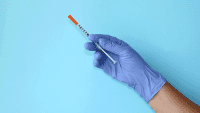Indications, equipment, and nursing care
- ETCO2 monitoring can depict early warning signs of clinical deterioration to the healthcare professional, as it correlates with cardiac output and pulmonary blood flow.
- Capnography incorporates respiratory rate and exhaled CO2 values, which helps clinicians detect early warning signs of ventilatory compromise prior to pulse oximetry readings.
- Explain various clinical scenarios where end-tidal CO2 (ETCO2) monitoring is crucial.
- Recognize the advantages of ETCO2 monitoring over pulse oximetry.
- Understand the limitations of ETCO2 monitoring and the importance of other monitoring techniques such as arterial blood gas analysis.
No relevant financial relationships were identified for any individuals with the ability to control content of the activity.
Expiration: 9/1/27
End-tidal carbon dioxide (ETCO2) monitoring, noninvasive measurement of exhaled CO2, provides valuable insight into a patient’s metabolism (production of CO2 as a byproduct of cellular metabolism), perfusion (transport of CO2 into the lungs), and ventilation (expulsion of CO2 via the respiratory system). ETCO2 can be a numerical value (capnometry), or when coupled with a patient’s respiratory rate, a graphical-numerical value (capnography). ETCO2 represents the partial pressure of CO2 within arterial and venous blood, which serves as an important marker of alveolar ventilation. As a result, ETCO2 monitoring can aid early detection of clinical deterioration related to cardiac output and pulmonary blood flow.
Continuous-waveform capnography: A crucial tool for ED clinicians
Understanding end-tidal CO2 monitoring
The why
Clinical use of capnography began in the 1950s when capnograph monitors became available via modern infrared technology. Advances in ETCO2 continuous monitoring technology over the past 70 years have made capnography a key vital sign component to ensure patient safety during anesthesia. The American Society of Anesthesiologists endorses capnography as a standard of care for general anesthesia as well as moderate and deep procedural sedation.
By incorporating a patient’s respiratory rate and exhaled CO2 values, capnography helps clinicians detect early warning signs of ventilatory compromise earlier than pulse oximetry readings (blood oxygen saturation levels). For this reason, other specialties outside of the operating room—critical care, toxicology, emergency medicine—should use ETCO2 capnography monitoring as a standard of care.
ETCO2 monitoring provides clinicians with an accurate approximation of the partial pressure of carbon dioxide (paCO2), which represents alveolar CO2. Clinicians can monitor ETCO2 invasively or noninvasively to guide decision making; paCO2 readings are obtained invasively by collecting arterial blood gas (ABG) samples. In healthy patients with normal lung function, typical capnometry readings range between 35 and 45 mmHg. A normal ETCO2 reading typically is 2 to 5 mmHg less than the corresponding paCO2 value. ETCO2 and paCO2 correlations increase in variability with age, pulmonary disease, cardiac dysfunction, and other conditions commonly found in patients admitted for hemodynamic or respiratory instability.
This variability differs significantly in patients with unhealthy lungs. In fact, when ventilator settings are adjusted or patients are followed over time, changes in ETCO2 and PaCO2 are poorly correlated and may even go in opposite directions. Therefore, ABG sampling is the preferred monitoring tool for patients receiving mechanical ventilation. The inherent inaccuracies in ETCO2 require cautious use as a surrogate for PaCO2 when caring for patients with unhealthy lungs who require mechanical ventilation.
The when
Many indications exist for ETCO2 monitoring in various clinical settings. For example, it helps confirm tracheal airway placement and rules out esophageal placement. After artificial airway placement, deliver six breaths via a bag-valve oxygen delivery device and then measure ETCO2. Taking readings before six breaths could lead to false high readings if the patient consumed antacids, recently drank a carbonated beverage, or had bag or mask ventilation before intubation. Continuous ETCO2 monitoring of patients with artificial airways can help detect the migration or loss of the airway, especially during transport.
Capnography can serve as an early indicator of airway compromise and as a more accurate indicator of tube dislodgement than auscultation. It also offers insight into respiratory and cardiovascular function by providing information about ventilation and CO2 removal that continuous pulse oximetry doesn’t. Poor ventilation and rising CO2 can lead to respiratory acidosis and cardiovascular collapse, which may go undetected with pulse oximetry. Capnography helps identify abnormalities of exhaled air flow, CO2 elimination, and the ratio of dead-space volume to tidal volume, which optimize mechanical ventilation.
ETCO2 monitoring has multiple uses during cardiopulmonary resuscitation (CPR), including as an important feedback mechanism for chest compressions. Adequate compressions should result in ETCO2 readings between 10 and 20 mmHg. Readings of less than 10 mmHg signify slow and shallow compressions, which may indicate performer fatigue. Code leader feedback should include a plan to change chest compression performers to improve compression quality. During CPR, continuous capnography also aids in detecting rapid CO2 upstroke, which could indicate a return of spontaneous circulation. Evidence also suggests an association between persistently low ETCO2 readings during CPR and overall poor outcomes.
Patients undergoing anesthesia or procedural sedation should receive continuous ETCO2 monitoring before, during, and when recovering from sedation administration. Gallagher’s research has shown that patients who receive ETCO2 monitoring during sedation have decreased rates of hypoxic events. Because patients may have increased ETCO2 readings while their pulse oximetry remains normal or at baseline, monitoring helps clinicians ensure adequate ventilation during the procedure. Compared to pulse oximetry monitoring alone, ETCO2 monitoring helps clinicians recognize hypoventilation or apneic events more rapidly.
ETCO2 monitoring also can aid detection of opioid-induced respiratory depression. Patients who are intoxicated or sedated from accidental or intentional drug overdose may have impaired ventilation. Similar to treating patients undergoing anesthesia or sedation, ETCO2 monitoring can assist the clinician in differentiating effective vs ineffective ventilation in obtunded or unconscious patients. Patients with an altered mental status, such as those who’ve had a seizure, also benefit from ETCO2 monitoring as changes in capnography typically precede changes in pulse oximetry readings during hypoxic events.
Research continues to explore the use of ETCO2 monitoring when predicting fluid responsiveness. Fluid therapy is a fine line to navigate as hypovolemic patients need volume to maintain homeostasis and prevent organ ischemia; however, too much volume can lead to fluid overload. The noninvasive passive leg raise (PLR) test gives patients a reversible bolus of fluid by allowing blood to drain back to the heart. It simulates the effects of a fluid bolus and increases preload. Toupin and colleagues studied the PLR test on patients while continuously monitoring their ETCO2 and correlating these readings with ongoing hemodynamic monitoring of cardiac output, heart rate, and mean arterial pressure. ETCO2 changes >2 mmHG immediately after the PLR test predict a patient’s responsiveness to a fluid bolus. This research aims to remove the need for invasive testing, particularly on patients receiving ventilation in intensive care.
The how
Various methods of obtaining ETCO2 readings exist, but the most common are the sidestream and mainstream methods. With sidestream, small bore tubing carries exhaled gas to a monitor for analysis. This tubing can be in nasal cannula form or attached to an endotracheal tube. Nasal cannulas with extension pieces may be the best option for patients who breath primarily through their mouths.
In the mainstream method, a CO2 analyzer placed close to the exhaled gas is attached directly to a nasal cannula, mask (most frequently used with pediatric patients), or ventilator circuit. (See Mainstream vs sidestream.)
Mainstream vs sidestream
The most common methods for monitoring end-tidal carbon dioxide are mainstream and sidestream. The mainstream method uses a carbon dioxide analyzer (infrared sensor in the image below) located near exhaled gas. Sidestream uses small-bore tubing to carry gas to the monitor.


Monitoring equipment
The monitors analyzing the ETCO2 samples delivered via sidestream or mainstream methods can operate as a standalone system or by incorporation into the physiologic monitor of the ventilator circuit. For patients who aren’t intubated, supplemental oxygen can be delivered via an ETCO2 reading–capable nasal cannula or mask simultaneously with monitoring.
Patient-controlled analgesia infusion pumps can integrate ETCO2 monitoring technology with medication delivery. Using the sidestream method, the ETCO2 adaptor cable is plugged directly into the monitor module, which analyzes exhaled CO2, fractional inspired CO2, and respiratory rate for patients who are intubated and those who aren’t. This monitoring aids in reducing opioid-induced respiratory depression by pausing an opioid infusion when clinical parameters aren’t met and alerts clinicians via an alarm system.
A colorimetric CO2 detector helps to verify proper endotracheal tube placement during intubation. The detector contains a pH-sensitive chemical indicator that changes color from purple/blue to yellow in the presence of CO2. Use it only for verifying airway tube placement; it can’t provide a numerical value or graph ETCO2 waveforms.
Waveform analysis
Successful capnography use requires that healthcare professionals can interpret the waveforms. ETCO2 monitoring technology consists of light passing from an infrared capnometer through a patient’s exhaled gas and measuring the absorption of light by the gas. As CO2 increases, more light is absorbed, which results in the capnography waveform.
In typical conditions, four important phases occur in an ETCO2 capnography waveform. The first phase represents the respiratory baseline, which contains dead space gas typically free of CO2. The second occurs at the beginning of exhalation represented by a rapid upstroke in the waveform. Next comes the leveling of the upstroke and alveolar plateau—the peak point or end-tidal value in capnometry. In the fourth phase, a rapid downstroke of the waveform represents inhalation, which contains no CO2.
Several different waveforms can occur depending on a patient’s condition. For example, patients with chronic obstructive pulmonary disease (a chronic inflammatory lung condition that obstructs airflow from the lungs, which results in CO2 retention) have a unique ETCO2 waveform that takes on a shark fin appearance with no plateau, which typically occurs in the third phase. This shark fin appearance correlates with the patient’s inability to adequately eliminate CO2. (See Capnography waveforms.)
Capnography waveforms
Capnography waveforms vary based on the patient’s condition.


Nursing implications
Nurses caring for patients on ETCO2 monitoring should have awareness of ETCO2 alarms. In the event a patient’s alarm sounds, first assess the patient for distress, check the airway for occlusion, remove any obstructions, and adjust any twisted tubing. If the patient isn’t in distress and you don’t see a need for immediate intervention, determine why the alarm sounded. Alarms can indicate loose equipment connections, the need for patient repositioning (potentially using airway positioning supports), and a change in waveform quality. If the alarm continues, collaborate with the provider and respiratory therapy team to troubleshoot the issue. If necessary and ordered by the provider, replace the patient’s equipment. (See ETCO2 monitoring: Nursing steps.)
ETCO2 monitoring: Nursing steps
After identifying the patient by using two unique identifiers, discuss the reasons for applying the ETCO2 monitoring device with the patient and their family. Answer questions as you’re able, and ask for other team members’ input as needed.
- Assemble the equipment and, if required, calibrate the ETCO2 monitoring system per the manufacturer’s instructions.
- Perform hand hygiene and don the appropriate personal protective equipment (PPE) before applying the device chosen for the patient.
- For patients who aren’t intubated, apply the ETCO2 reading–capable nasal cannula or mask.
- For patients who are intubated, apply the airway adaptor and sensor to the circuit as close to the patient’s ventilator connection as possible.
- When attaching the equipment, ensure the infrared technology is proximal to the circuit to stop condensation from obstructing light transmission to the sensor.
- Ensure all tubes and connections are free of kinks and obstructions.
- Connect the appropriate patient cable or adaptor into the display equipment (monitor, circuit, or pump module).
- Set the appropriate alarms for the clinical indication and begin monitoring.
- Remove and discard supplies and PPE and perform hand hygiene.
- Document the procedure in the patient’s electronic health record.
Patient and family education
You can help patients and their families understand the need for ETCO2 monitoring. Explain that it can detect early changes in clinical status, which helps prevent harm. To reduce any anxiety and increase adherence with wearing necessary devices, explain the procedure and the purpose of the required equipment. Education is particularly important for patients who aren’t intubated and must use the mainstream capnography device; the equipment can feel heavy when it sits close to the patient’s face. When they understand the importance of monitoring, patients may more likely adhere to wearing the equipment. Placing a protective dressing under the equipment can help reduce surface pressure.
A tool for safety
ETCO2 monitoring, a tool once used almost exclusively in patients receiving anesthesia, has proven useful in various settings, including the emergency department, medical–surgical units, critical care, ambulatory care, critical care transport, and postoperative suites. Longstanding evidence shows the importance of ETCO2 monitoring in many clinical situations, including intubation, CPR, and sedation. Current literature aims to link ETCO2 monitoring with fluid responsiveness predictability, but not enough established evidence exists to develop concrete evidence-based clinical guidelines. However, we do know that continuous ETCO2 monitoring provides healthcare professionals with real-time data to make clinical decisions that support patient safety and optimal outcomes, while minimizing the need for additional invasive procedures.
The authors work at the Hospital of the University of Pennsylvania in Philadelphia. Sinead Donnelly Hellings is a clinical practice lead, Jessica Fuller is director of nursing practice, and Stephanie Maillie is a clinical nurse specialist for quality.
American Nurse Journal. 2024; 19(9). Doi: 10.51256/ANJ092406
References
Ahrens T, Sona C. Capnography application in acute and critical care. AACN Clin Issues. 2003;14(2):123-32. doi:10.1097/00044067-200305000-00002
Ahrens T, Wijeweera H, Ray S. Capnography. A key underutilized technology. Crit Care Nurs Clin North Am. 1999;11(1):49-62.
Askar H, Misch J, Chen Z, Chadha S, Wang HL. Capnography monitoring in procedural intravenous sedation: A systematic review and meta-analysis. Clin Oral Investig. 2020;24(11):3761-70. doi: 10.1007/s00784-020-03395-1
Bhadade R, Harde M, de Souza R, Madke T. Assessment of fluid responsiveness by changes in end tidal carbon dioxide during passive leg raising test and fluid challenge. J Assoc Physicians India. 2022;70(5):11-2.
Çakmak F, Tekin E. Correlation of the end-tidal CO2 value with arterial blood gas parameters—Evaluation of the treatment efficacy of COPD exacerbation in the emergency department. Euro J Clin Exper Med. 2022;20(3):316-22. doi:10.15584/ejcem.2022.3.9
Gallagher JJ. Capnography monitoring during procedural sedation and analgesia. AACN Adv Crit Care. 2018;29(4):405-14. doi:10.4037/aacnacc2018684
Huang H, Wu C, Shen Q, Fang Y, Xu H. Value of variation of end-tidal carbon dioxide for predicting fluid responsiveness during the passive leg raising test in patients with mechanical ventilation: A systematic review and meta-analysis. Crit Care. 2022;26(1):20. doi:10.1186/s13054-022-03890-9
Khanna AK, Bergese SD, Jungquist CR, et al. Prediction of opioid-induced respiratory depression on inpatient wards using continuous capnography and oximetry: An International prospective, observational trial. Anesth Analg. 2020;131(4):1012-4. doi:10.1213/ANE.0000000000004788
Øberg EB, Jørgensen BG, Berthelsen PG. End-tidal CO2 in the diagnosis of fluid responsiveness—A systematic review. Dan Med J. 2019;66(9):A5560.
Panchal AR, Bartos JA, Cabañas JG, et al. Part 3: Adult basic and advanced life support: 2020 American Heart Association guidelines for cardiopulmonary resuscitation and emergency cardiovascular care. Circulation. 2020;142(16_suppl_2):S366-468. doi:10.1161/CIR.0000000000000916
Practice guidelines for sedation and analgesia by non-anesthesiologists. A report by the American Society of Anesthesiologists Task Force on Sedation and Analgesia by Non-Anesthesiologists. Anesthesiology. 1996;84(2):459-471. doi:10.1097/00000542-199602000-00029
Rackley CR. Monitoring during mechanical ventilation. Respir Care. 2020;65(6):832-46. doi:10.4187/respcare.07812
Salahuddin N, Baloch K, Memon, Ur Rehman A. Assessing fluid responsiveness in cardiogenic shock: ETCO2, Pv-aCO2 gap are the most useful. Crit Care Med. 2021;49(1):644. doi:10.1097/01.ccm.0000730996.38784.dd
Schallom L, Ahrens T. Will my patient survive this cardiac arrest?. Dimens Crit Care Nurs. 2002;21(2):62-3. doi: 10.1097/00003465-200203000-00003
Toupin F, Clairoux A, Deschamps A, et al. Assessment of fluid responsiveness with end-tidal carbon dioxide using a simplified passive leg raising maneuver: A prospective observational study. Can J Anaesth. 2016;63(9):1033-41. doi:10.1007/s12630-016-0677-z
Wang J, Zhang J, Liu Y, Shang H, Peng L, Cui Z. Relationship between end-tidal carbon dioxide and arterial carbon dioxide in critically ill patients on mechanical ventilation: A cross-sectional study. Medicine (Baltimore). 2021;100(33):e26973. doi:10.1097/MD.0000000000026973
Westhorpe RN, Ball C. The history of capnography. Anaesth Intensive Care. 2010;38(4):611.
Wiegand D. AACN Procedure Manual for High-Acuity, Progressive, and Critical Care. 7th ed. Philadelphia: Elsevier; 2016.
Key words: capnography, end-tidal carbon dioxide monitoring, capnometry



















1 Comment. Leave new
This was a great back to basics reminder on capnography and ETCO2 monitoring with a few little pearls mixed in that I was not aware of. Thank you!